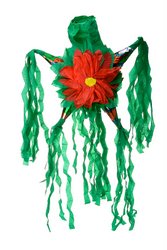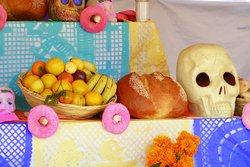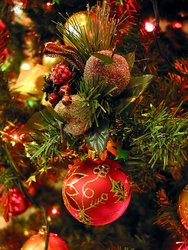|
Hispanic Traditions
Interested in learning about Hispanic traditions? Great! You've come to the right place. But before we get into the details of some of the most popular Latino traditions lets define the term "tradition". Tradition is...
Traditions help us connect with our people: country, community, family and friends. It is sort of like glue; it keeps us together. There are several Hispanic traditions – too many to list here. But just to give you a taste, here are a few of the most popular customs that are practiced in Latin America as well as in the United States: Hispanic Traditions - Las Piñatas
Where does it come from? Many experts believe that the piñata originated in Mexico. Archeological evidence shows that the Aztecs, Mayans and other native people had their own versions of the piñata. These early piñatas were pots made of clay which were broken (usually using sticks) to reveal its contents. Such items represented gifts from the gods. The piñata tradition is very popular in Central America and other Latin American countries, including Colombia, Ecuador, Peru, Puerto Rico, and Venezuela. This tradition has also spread to the United States. Modern tradition As a child in Central America, the "piñata ritual" went like this: a child would be selected to hit the piñata. He or she would then be blindfolded. With a stick or club, the child would attempt to break the piñata. Needless to say, some children (and adults) would end up being hit on the head. That wasn’t a pretty sight, let me tell you. Nowadays, the piñata is not broken. Instead, it is gently opened by pulling the strings attached to it. This is way safer than the older tradition. In my country, piñatas were used mainly to celebrate birthdays. But they were also broken during First Communions, Baptisms and other celebrations. The piñata remains a very popular and festive Hispanic tradition. Hispanic Traditions - Quince Años
The Fiesta Quinceanera marks the right of passage from girlhood to young womanhood. Each country and/or community has a slight variation of the celebration, but it generally consists of a big party with the Quinceañera as the focus of the event. For this special day, the girl wears a very elaborate dress, usually in a pastel color. Most parties also include a waltz, which the girl dances with her father, older brother or other male relative. Nowadays, many girls do opt for a less formal party and some even take a trip with family and/or friends as an alternative to the traditional "quince". Hispanic Traditions - Las MañanitasThis is a traditional Mexican birthday song (some people say that in fact, it is two songs in one). The tradition has spread to different Latin American countries, particularly in Central America where it has become widely popular. The song is usually sung in the morning and sometimes as a serenade (serenata). Here’s an excerpt of the song Las Mañanitas in Spanish, followed by a translation into English: Estas son las mañanitas, que cantaba el Rey David, Translation: This is the morning song that King David sang, Notes: * This verse can also be replaced by a las muchachas bonitas ** This term is usually replaced with the name of the birthday person
Las Mananitas - Find here the complete lyrics to this popular birthday song. Also find here background information and videos. Hispanic Traditions - Día de los Muertos (Day of the Dead)
This tradition is observed on November 2nd (All Souls’ Day according to the Catholic calendar). In Mexico and other countries November 1st is dedicated to honoring and remembering babies and children who have passed on. The date coincides with All Saints’ Day, which is celebrated by Catholics around the world. During the Day of the Dead, people remember family members and friends who have passed away. In Mexico, people erect "altares" (altars) in honor of the departed. These altars can be decorated with flowers, pictures of the deceased, fruits and other foodstuffs. Indeed, some of these altars can be quite elaborate (see picture above). On this day, people also go to the cemetery to "enflorar" (place flowers on the graves of family members and friends) and many spend the day there. Even though this day revolves around death, it is a very festive tradition which focuses on celebrating the life of those who have crossed to the other side. Hispanic Christmas TraditionsChristmas is one of the most popular Hispanic traditions. And there are many wonderful customs and practices associated with it. Some of the most popular traditions are:
I hope you enjoyed reading about these Latin traditions. And even though this is just a small sample, I hope they give you a glimpse into the richness of the Hispanic culture. I'll add new Hispanic traditions and updates regularly, so check back often.
Hispanic Holidays - A comprehensive list of Hispanic special celebrations and observances. Leave Hispanic Traditions and return to Hispanic Culture Return to the Home Page of Explore Hispanic Culture
|
 A piñata is a brightly-colored party ornament made from either a clay container or cardboard (usually embellished with papier-mâché). If made of cardboard, the piñata can be of any shape, including geometric forms, superheroes, flowers, and animals – among many others.
A piñata is a brightly-colored party ornament made from either a clay container or cardboard (usually embellished with papier-mâché). If made of cardboard, the piñata can be of any shape, including geometric forms, superheroes, flowers, and animals – among many others.  The Quince Años celebration - also known as Fiesta Quinceañera, Quinces or Fiesta Rosa – is a very popular tradition is most Latin American countries.
The Quince Años celebration - also known as Fiesta Quinceañera, Quinces or Fiesta Rosa – is a very popular tradition is most Latin American countries.  El Día de los Muertos (also known as Día de los Difuntos or Día de Finados ) is widely celebrated in most Latin American countries.
El Día de los Muertos (also known as Día de los Difuntos or Día de Finados ) is widely celebrated in most Latin American countries. 